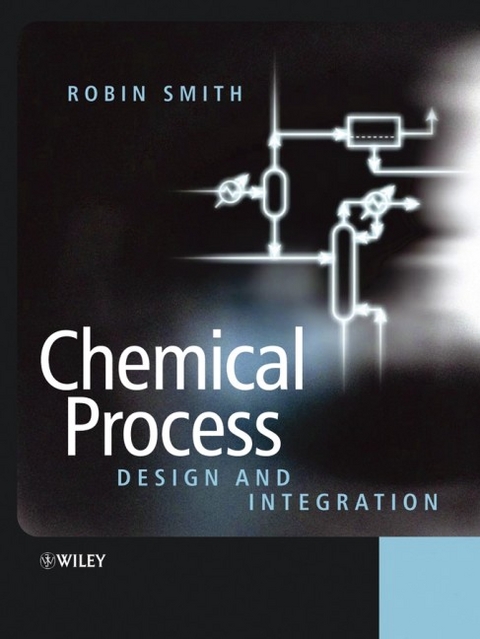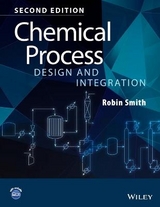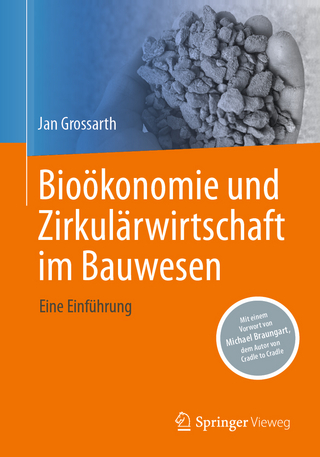
Chemical Process
John Wiley & Sons Inc (Verlag)
978-0-471-48681-7 (ISBN)
- Titel erscheint in neuer Auflage
- Artikel merken
This book deals with the design and integration of chemical processes, emphasizing the conceptual issues that are fundamental to the creation of the process. Chemical process design requires the selection of a series of processing steps and their integration to form a complete manufacturing system. The text emphasizes both the design and selection of the steps as individual operations and their integration. Also, the process will normally operate as part of an integrated manufacturing site consisting of a number of processes serviced by a common utility system. The design of utility systems has been dealt with in the text so that the interactions between processes and the utility system and interactions between different processes through the utility system can be exploited to maximize the performance of the site as a whole. Chemical processing should form part of a sustainable industrial activity. For chemical processing, this means that processes should use raw materials as efficiently as is economic and practicable, both to prevent the production of waste that can be environmentally harmful and to preserve the reserves of raw materials as much as possible.
Processes should use as little energy as economic and practicable, both to prevent the build-up of carbon dioxide in the atmosphere from burning fossil fuels and to preserve reserves of fossil fuels. Water must also be consumed in sustainable quantities that do not cause deterioration in the quality of the water source and the long-term quantity of the reserves. Aqueous and atmospheric emissions must not be environmentally harmful, and solid waste to landfill must be avoided. Finally, all aspects of chemical processing must feature good health and safety practice. It is important for the designer to understand the limitations of the methods used in chemical process design. The best way to understand the limitations is to understand the derivations of the equations used and the assumptions on which the equations are based. Where practical, the derivation of the design equations has been included in the text. The book is intended to provide a practical guide to chemical process design and integration for undergraduate and postgraduate students of chemical engineering, practicing process designers and chemical engineers and applied chemists working in process development.
Examples have been included throughout the text. Most of these examples do not require specialist software and can be performed on spreadsheet software. Finally, a number of exercises have been added at the end of each chapter to allow the reader to practice the calculation procedures.
Professor Robin Smith is Head of the Centre for Process Integration at the University of Manchester Institute of Science and Technology (UMIST) in the United Kingdom. Before joining UMIST he had extensive industrial experience with Rohm & Haas in process investigation and process design, and with ICI in computer-aided design and process integration. He was a member of the ICI Process Integration Team that pioneered the first industrial applications of process integration design methods. Since joining UMIST he has acted extensively as a consultant in process integration projects. He has published widely in the field of chemical process design and integration, and is a Fellow of the Royal Academy of Engineering, a Fellow of the Institution of Chemical Engineers in the UK and a chartered engineer. In 1992 he was awarded the Hanson Medal of the Institution of Chemical Engineers in the UK for his work on clean process technology.
Preface. Acknowledgements. Nomenclature. Chapter 1 The Nature of Chemical Process Design and Integration. 1.1 Chemical Products. 1.2 Formulation of the Design Problem. 1.3 Chemical Process Design and Integration. 1.4 The Hierarchy of Chemical Process Design and Integration. 1.5 Continuous and Batch Processes. 1.6 New Design and Retrofit. 1.7 Approaches to Chemical Process Design and Integration. 1.8 Process Control. 1.9 The Nature of Chemical Process Design and Integration - Summary. References. Chapter 2 Process Economics. 2.1 The Role of Process Economics. 2.2 Capital Cost for New Design. 2.3 Capital Cost for Retrofit. 2.4 Annualized Capital Cost. 2.5 Operating Cost. 2.6 Simple Economic Criteria. 2.7 Project Cash Flow and Economic Evaluation. 2.8 Investment Criteria. 2.9 Process Economics - Summary. 2.10 Exercises. References. Chapter 3 Optimization. 3.1 Objective Functions. 3.2 Single-variable Optimization. 3.3 Multivariable Optimization. 3.4 Constrained Optimization. 3.5 Linear Programming. 3.6 Nonlinear Programming. 3.7 Profile Optimization. 3.8 Structural Optimization. 3.9 Solution of Equations using Optimization. 3.10 The Search for Global Optimality. 3.11 Summary - Optimization. 3.12 Exercises. References. Chapter 4 Thermodynamic Properties and Phase Equilibrium. 4.1 Equations of State. 4.2 Phase Equilibrium for Single Components. 4.3 Fugacity and Phase Equilibrium. 4.4 Vapor-Liquid Equilibrium. 4.5 Vapor-Liquid Equilibrium Based on Activity Coefficient Models. 4.6 Vapor-Liquid Equilibrium Based on Equations of State. 4.7 Calculation of Vapor-Liquid Equilibrium. 4.8 Liquid-Liquid Equilibrium. 4.9 Liquid-Liquid Equilibrium Activity Coefficient Models. 4.10 Calculation of Liquid-Liquid Equilibrium. 4.11 Calculation of Enthalpy. 4.12 Calculation of Entropy. 4.13 Phase Equilibrium and Thermodynamic Properties - Summary. 4.14 Exercises. References. Chapter 5 Choice of Reactor I - Reactor Performance. 5.1 Reaction Path. 5.2 Types of Reaction Systems. 5.3 Reactor Performance. 5.4 Rate of Reaction. 5.5 Idealized Reactor Models. 5.6 Choice of Idealized Reactor Model. 5.7 Choice of Reactor Performance. 5.8 Choice of Reactor Performance - Summary. 5.9 Exercises. References. Chapter 6 Choice of Reactor II - Reactor Conditions. 6.1 Reaction Equilibrium. 6.2 Reactor Temperature. 6.3 Reactor Pressure. 6.4 Reactor Phase. 6.5 Reactor Concentration. 6.6 Biochemical Reactions. 6.7 Catalysts. 6.8 Choice of Reactor Conditions - Summary. 6.9 Exercises. References. Chapter 7 Choice of Reactor III - Reactor Configuration. 7.1 Temperature Control. 7.2 Catalyst Degradation. 7.3 Gas-Liquid and Liquid-Liquid Reactors. 7.4 Reactor Configuration. 7.5 Reactor Configuration for Heterogeneous Solid-Catalyzed Reactions. 7.6 Reactor Configuration from Optimization of a Superstructure. 7.7 Choice of Reactor Configuration - Summary. 7.8 Exercises. References. Chapter 8 Choice of Separator for Heterogeneous Mixtures. 8.1 Homogeneous and Heterogeneous Separation. 8.2 Settling and Sedimentation. 8.3 Inertial and Centrifugal Separation. 8.4 Electrostatic Precipitation. 8.5 Filtration. 8.6 Scrubbing. 8.7 Flotation. 8.8 Drying. 8.9 Separation of Heterogeneous Mixtures - Summary. 8.10 Exercises. References. Chapter 9 Choice of Separator for Homogeneous Fluid Mixtures I - Distillation. 9.1 Single-Stage Separation. 9.2 Distillation. 9.3 Binary Distillation. 9.4 Total and Minimum Reflux Conditions for Multicomponent Mixtures. 9.5 Finite Reflux Conditions for Multicomponent Mixtures. 9.6 Choice of Operating Conditions. 9.7 Limitations of Distillation. 9.8 Separation of Homogeneous Fluid Mixtures by Distillation - Summary. 9.9 Exercises. References. Chapter 10 Choice of Separator for Homogeneous Fluid Mixtures II - Other Methods. 10.1 Absorption and Stripping. 10.2 Liquid-Liquid Extraction. 10.3 Adsorption. 10.4 Membranes. 10.5 Crystallization. 10.6 Evaporation. 10.7 Separation of Homogeneous Fluid Mixtures by Other Methods - Summary. 10.8 Exercises. References. Chapter 11 Distillation Sequencing. 11.1 Distillation Sequencing Using Simple Columns. 11.2 Practical Constraints Restricting Options. 11.3 Choice of Sequence for Simple Nonintegrated Distillation Columns. 11.4 Distillation Sequencing Using Columns With More Than Two Products. 11.5 Distillation Sequencing Using Thermal Coupling. 11.6 Retrofit of Distillation Sequences. 11.7 Crude Oil Distillation. 11.8 Distillation Sequencing Using Optimization of a Superstructure. 11.9 Distillation Sequencing - Summary. 11.10 Exercises. References. Chapter 12 Distillation Sequencing for Azeotropic Distillation. 12.1 Azeotropic Systems. 12.2 Change in Pressure. 12.3 Representation of Azeotropic Distillation. 12.4 Distillation at Total Reflux Conditions. 12.5 Distillation at Minimum Reflux Conditions. 12.6 Distillation at Finite Reflux Conditions. 12.7 Distillation Sequencing Using an Entrainer. 12.8 Heterogeneous Azeotropic Distillation. 12.9 Entrainer Selection. 12.10 Trade-offs in Azeotropic Distillation. 12.11 Multicomponent Systems. 12.12 Membrane Separation. 12.13 Distillation Sequencing for Azeotropic Distillation - Summary. 12.14 Exercises. References. Chapter 13 Reaction, Separation and Recycle Systems for Continuous Processes. 13.1 The Function of Process Recycles. 13.2 Recycles with Purges. 13.3 Pumping and Compression. 13.4 Simulation of Recycles. 13.5 The Process Yield. 13.6 Optimization of Reactor Conversion. 13.7 Optimization of Processes Involving a Purge. 13.8 Hybrid Reaction and Separation. 13.9 Feed, Product and Intermediate Storage. 13.10 Reaction, Separation and Recycle Systems for Continuous Processes - Summary. 13.11 Exercises. References. Chapter 14 Reaction, Separation and Recycle Systems for Batch Processes. 14.1 Batch Processes. 14.2 Batch Reactors. 14.3 Batch Separation Processes. 14.4 Gantt Charts. 14.5 Production Schedules for Single Products. 14.6 Production Schedules for Multiple Products. 14.7 Equipment Cleaning and Material Transfer. 14.8 Synthesis of Reaction and Separation Systems for Batch Processes. 14.9 Optimization of Batch Processes. 14.10 Storage in Batch Processes. 14.11 Reaction and Separation Systems for Batch Processes - Summary. 14.12 Exercises. References. Chapter 15 Heat Exchanger Networks I - Heat Transfer Equipment. 15.1 Overall Heat Transfer Coefficients. 15.2 Heat Transfer Coefficients and Pressure Drops for Shell-and-Tube Heat Exchangers. 15.3 Temperature Differences in Shell-and-Tube Heat Exchangers. 15.4 Allocation of Fluids in Shell-and-Tube Heat Exchangers. 15.5 Extended Surface Tubes. 15.6 Retrofit of Heat Exchangers. 15.7 Condensers. 15.8 Reboilers and Vaporizers. 15.9 Other Types of Heat Exchange Equipment. 15.10 Fired Heaters. 15.11 Heat Transfer Equipment - Summary. 15.12 Exercises. References. Chapter 16 Heat Exchanger Networks II - Energy Targets. 16.1 Composite Curves. 16.2 The Heat Recovery Pinch. 16.3 Threshold Problems. 16.4 The Problem Table Algorithm. 16.5 Nonglobal Minimum Temperature Differences. 16.6 Process Constraints. 16.7 Utility Selection. 16.8 Furnaces. 16.9 Cogeneration (Combined Heat and Power Generation). 16.10 Integration Of Heat Pumps. 16.11 Heat Exchanger Network Energy Targets - Summary. 16.12 Exercises. References. Chapter 17 Heat Exchanger Networks III - Capital and Total Cost Targets. 17.1 Number of Heat Exchange Units. 17.2 Heat Exchange Area Targets. 17.3 Number-of-shells Target. 17.4 Capital Cost Targets. 17.5 Total Cost Targets. 17.6 Heat Exchanger Network and Utilities Capital and Total Costs - Summary. 17.7 Exercises. References. Chapter 18 Heat Exchanger Networks IV - Network Design. 18.1 The Pinch Design Method. 18.2 Design for Threshold Problems. 18.3 Stream Splitting. 18.4 Design for Multiple Pinches. 18.5 Remaining Problem Analysis. 18.6 Network Optimization. 18.7 The Superstructure Approach to Heat Exchanger Network Design. 18.8 Retrofit of Heat Exchanger Networks. 18.9 Addition of New Heat Transfer Area in Retrofit. 18.10 Heat Exchanger Network Design - Summary. 18.11 Exercises. References. Chapter 19 Heat Exchanger Networks V - Stream Data. 19.1 Process Changes for Heat Integration. 19.2 The Trade-Offs Between Process Changes, Utility Selection, Energy Cost and Capital Cost. 19.3 Data Extraction. 19.4 Heat Exchanger Network Stream Data - Summary. 19.5 Exercises. References. Chapter 20 Heat Integration of Reactors. 20.1 The Heat Integration Characteristics of Reactors. 20.2 Appropriate Placement of Reactors. 20.3 Use of the Grand Composite Curve for Heat Integration of Reactors. 20.4 Evolving Reactor Design to Improve Heat Integration. 20.5 Heat Integration of Reactors - Summary. Reference. Chapter 21 Heat Integration of Distillation Columns. 21.1 The Heat Integration Characteristics of Distillation. 21.2 The Appropriate Placement of Distillation. 21.3 Use of the Grand Composite Curve for Heat Integration of Distillation. 21.4 Evolving the Design of Simple Distillation Columns to Improve Heat Integration. 21.5 Heat Pumping in Distillation. 21.6 Capital Cost Considerations. 21.7 Heat Integration Characteristics of Distillation Sequences. 21.8 Heat-integrated Distillation Sequences Based on the Optimization of a Superstructure. 21.9 Heat Integration of Distillation Columns - Summary. 21.10 Exercises. References. Chapter 22 Heat Integration of Evaporators and Dryers. 22.1 The Heat Integration Characteristics of Evaporators. 22.2 Appropriate Placement of Evaporators. 22.3 Evolving Evaporator Design to Improve Heat Integration. 22.4 The Heat Integration Characteristics of Dryers. 22.5 Evolving Dryer Design to Improve Heat Integration. 22.6 Heat Integration of Evaporators and Dryers - Summary. 22.7 Exercises. References. Chapter 23 Steam Systems and Cogeneration. 23.1 Boiler Feedwater Treatment. 23.2 Steam Boilers. 23.3 Steam Turbines. 23.4 Gas Turbines. 23.5 Steam System Configuration. 23.6 Steam and Power Balances. 23.7 Site Composite Curves. 23.8 Cogeneration Targets. 23.9 Optimization of Steam Levels. 23.10 Site Power-to-heat Ratio. 23.11 Optimizing Steam Systems. 23.12 Steam Costs. 23.13 Choice of Driver. 23.14 Steam Systems and Cogeneration - Summary. 23.15 Exercises. References. Chapter 24 Cooling and Refrigeration Systems. 24.1 Cooling Systems. 24.2 Recirculating Cooling Water Systems. 24.3 Targeting Minimum Cooling Water Flowrate. 24.4 Design of Cooling Water Networks. 24.5 Retrofit of Cooling Water Systems. 24.6 Refrigeration Cycles. 24.7 Process Expanders. 24.8 Choice of Refrigerant for Compression Refrigeration. 24.9 Targeting Refrigeration Power for Compression Refrigeration. 24.10 Heat Integration of Compression Refrigeration Processes. 24.11 Mixed Refrigerants for Compression Refrigeration. 24.12 Absorption Refrigeration. 24.13 Indirect Refrigeration. 24.14 Cooling Water and Refrigeration Systems - Summary. 24.15 Exercises. References. Chapter 25 Environmental Design for Atmospheric Emissions. 25.1 Atmospheric Pollution. 25.2 Sources of Atmospheric Pollution. 25.3 Control of Solid Particulate Emissions to Atmosphere. 25.4 Control of VOC Emissions to Atmosphere. 25.5 Control of Sulfur Emissions. 25.6 Control of Oxides of Nitrogen Emissions. 25.7 Control of Combustion Emissions. 25.8 Atmospheric Dispersion. 25.9 Environmental Design for Atmospheric Emissions - Summary. 25.10 Exercises. References. Chapter 26 Water System Design. 26.1 Aqueous Contamination. 26.2 Primary Treatment Processes. 26.3 Biological Treatment Processes. 26.4 Tertiary Treatment Processes. 26.5 Water Use. 26.6 Targeting Maximum Water Reuse for Single Contaminants. 26.7 Design for Maximum Water Reuse for Single Contaminants. 26.8 Targeting and Design for Maximum Water Reuse Based on Optimization of a Superstructure. 26.9 Process Changes for Reduced Water Consumption. 26.10 Targeting Minimum Wastewater Treatment Flowrate for Single Contaminants. 26.11 Design for Minimum Wastewater Treatment Flowrate for Single Contaminants. 26.12 Regeneration of Wastewater. 26.13 Targeting and Design for Effluent Treatment and Regeneration Based on Optimization of a Superstructure. 26.14 Data Extraction. 26.15 Water System Design - Summary. 26.16 Exercises. References. Chapter 27 Inherent Safety. 27.1 Fire. 27.2 Explosion. 27.3 Toxic Release. 27.4 Intensification of Hazardous Materials. 27.5 Attenuation of Hazardous Materials. 27.6 Quantitative Measures of Inherent Safety. 27.7 Inherent Safety - Summary. 27.8 Exercises. References. Chapter 28 Clean Process Technology. 28.1 Sources of Waste from Chemical Production. 28.2 Clean Process Technology for Chemical Reactors. 28.3 Clean Process Technology for Separation and Recycle Systems. 28.4 Clean Process Technology for Process Operations. 28.5 Clean Process Technology for Utility Systems. 28.6 Trading off Clean Process Technology Options. 28.7 Life Cycle Analysis. 28.8 Clean Process Technology - Summary. 28.9 Exercises. References. Chapter 29 Overall Strategy for Chemical Process Design and Integration. 29.1 Objectives. 29.2 The Hierarchy. 29.3 The Final Design. Appendix A Annualization of Capital Cost. Appendix B Gas Compression. B.1 Reciprocating Compressors. B.2 Centrifugal Compressors. B.3 Staged Compression. Appendix C Heat Transfer Coefficients and Pressure Drop in Shell-and-tube Heat Exchangers. C.1 Pressure Drop and Heat Transfer Correlations for the Tube-Side. C.2 Pressure Drop and Heat Transfer Correlations for the Shell-Side. References. Appendix D The Maximum Thermal Effectiveness for 1-2 Shell-and-tube Heat Exchangers. Appendix E Expression for the Minimum Number of 1-2 Shell-and-tube Heat Exchangers for a Given Unit. Appendix F Algorithm for the Heat Exchanger Network Area Target. Appendix G Algorithm for the Heat Exchanger Network Number of Shells Target. G.1 Minimum Area Target for Networks of 1-2 Shells. References. Appendix H Algorithm for Heat Exchanger Network Capital Cost Targets. Index.
| Erscheint lt. Verlag | 1.3.2005 |
|---|---|
| Zusatzinfo | Illustrations |
| Verlagsort | New York |
| Sprache | englisch |
| Maße | 216 x 279 mm |
| Gewicht | 1728 g |
| Themenwelt | Naturwissenschaften ► Biologie ► Ökologie / Naturschutz |
| Naturwissenschaften ► Chemie ► Technische Chemie | |
| Technik ► Umwelttechnik / Biotechnologie | |
| ISBN-10 | 0-471-48681-7 / 0471486817 |
| ISBN-13 | 978-0-471-48681-7 / 9780471486817 |
| Zustand | Neuware |
| Haben Sie eine Frage zum Produkt? |
aus dem Bereich



